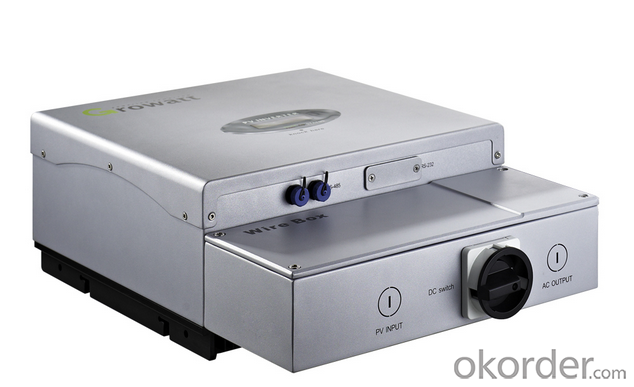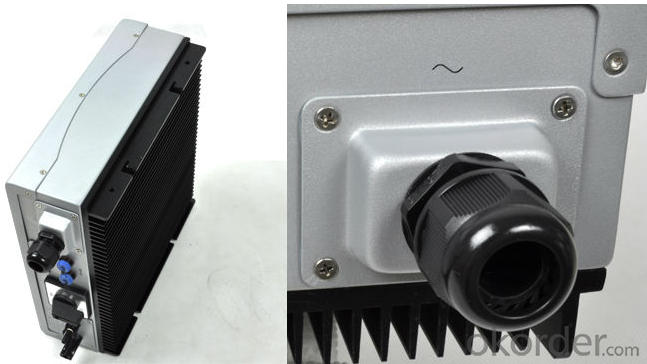Grid Tied Solar Inverter 8000w-11000w max 8300w TUV/UL/CSA/FCC
- Loading Port:
- Shekou
- Payment Terms:
- TT or LC
- Min Order Qty:
- 10 pc
- Supply Capability:
- 100000 pc/month
OKorder Service Pledge
OKorder Financial Service
You Might Also Like
Grid Tied Solar inverter 8000-11000kw
High efficiency of 97.8% delivery more energy
Integrated DC disconnect switch
Consistent and stable performance across entire input voltage and output power voltage
Intelligent temperature management
Power balancer for three-phase grid connection
Bluetooth/ RF technology/ Wi-Fi
Sound control, easy installation maintenance procedure
Newest generation IGBTs and advanced MPPT algorithms
8000TL-US | 9000TL-US | 10000TL-US | 11000TL-US | |
| Inputdata | ||||
| Max. DC power | 8300W | 9300W | 10350W | 11400W |
| Max. DC voltage | 600V | 600V | 600V | 600V |
| Start Voltage | 360V | 360V | 360V | 360V |
| DC nominal voltage | 345V@ 208VAC 379V@ 240VAC | 345V@ 208VAC 379V@ 240VAC | 345V@ 208VAC 379V@ 240VAC | 379V |
| PV voltage range | 300-600V@208V 345-600V@240V | 300-600V@208V 345-600V@240V | 300-600V@208V 345-600V@240V | 345-600V@208V 345-600V@240V |
| MPP voltage range(full load) | 300-480V@208V 345-480V@240V | 300-480V@208V 345-480V@240V | 300-480V@208V 345-480V@240V | 300-480V@208V 345-480V@240V |
| Max. input current/per string | 30A/16A | 33A/16A | 36A/16A | 35A/16A |
| Number of MPP trackers/ strings per MPP tracker | 1/4 | 1/4 | 1/4 | 1/4 |
| Efficiency | ||||
Max.efficiency | 97.8% | 97.8% | 97.8% | 97.5% |
| Rated AC output power | 8000W | 9000W | 10000W | 11000W |
| AC nominal voltage; range | 208V/240V;183-229V@208V,211-264V@240V | |||
| Max. output current | 44A@208V 38A@240V | 44A@208V 38A@240V | 44A@208V 38A@240V | 38A@240V |
| AC grid frequency; range | 60Hz; 59.3-60.5Hz | 60Hz; 59.3-60.5Hz | 60Hz; 59.3-60.5Hz | 60Hz; 59.3-60.5Hz |
| Power factor | 1 | 1 | 1 | 1 |
| THDI | <3% | <3% | <3% | <3% |
| Grid connection type | Two phase | Two phase | Two phase | Two phase |
| Features | ||||
Display Warranty: 10years/15years | LCD opt/opt/opt | LCD opt/opt/opt yes/opt | LCD yes/yes/ opt/opt/opt yes/opt | LCD opt/opt/opt yes/opt |
| Generaldata | ||||
Dimensions(W/H/D) in mm Weight Operating temperature range Noise emission(typical) Self-Consumption (night) Topology Cooling concept Environmental Protection rating Altitude Relative Humidity | 400/743/222 40KG -25℃ ... +60℃ <46db(a)< p=""> <0.5W Transformerless Smart cooling NEMA 3R 2000m withoutderating 0~100% | 400/743/222 40KG -25℃ ... +60℃ <46db(a)< p=""> <0.5W Transformerless Smart cooling NEMA 3R 2000m withoutderating 0~100% | 400/743/222 40KG -25℃ ... +60℃ <46db(a)< p=""> <0.5W Transformerless Smart cooling NEMA 3R 2000m withoutderating 0~100% | 400/743/222 40KG -25℃ ... +60℃ <46db(a)< p=""> <0.5W Transformerless Smart cooling NEMA 3R 2000m withoutderating 0~100% |
| Certificates and ApprovalsUL 1741, UL 1998, IEEE 1547, FCC part 15(Class B), CSA C22.2 No. 107.1 |


- Q:How does a grid-tied solar inverter function?
- A grid-tied solar inverter functions by converting the direct current (DC) produced by solar panels into usable alternating current (AC) that can be fed into the electrical grid. This inverter synchronizes the frequency and voltage of the generated electricity with that of the grid, allowing for seamless integration and distribution of solar power to homes and businesses. Additionally, it continuously monitors the grid voltage and shuts down in the event of a power outage to ensure safety and prevent back-feeding.
- Q:Can a solar inverter be used in a mobile or portable solar power system?
- Yes, a solar inverter can be used in a mobile or portable solar power system. The inverter converts the direct current (DC) generated by the solar panels into alternating current (AC), which is required to power most electronic devices. By incorporating a solar inverter, the mobile or portable solar power system can provide AC power for various applications, such as charging electronic devices or running small appliances, making it a versatile and convenient solution for powering devices on the go.
- Q:What is the role of isolation in a solar inverter?
- The role of isolation in a solar inverter is to provide safety and protection by electrically separating the DC input side (solar panels) from the AC output side (grid or load) to prevent any potential hazards such as electrical shocks, short circuits, or ground faults. It also helps in reducing noise interference and improving the overall performance and efficiency of the inverter.
- Q:What is the role of a surge protector in a solar inverter?
- The role of a surge protector in a solar inverter is to protect the sensitive electronic components of the inverter from power surges or voltage spikes that may occur in the electrical grid. By diverting excess voltage away from the inverter, it helps to prevent damage and ensure the reliable operation of the solar system.
- Q:What are the common issues and troubleshooting steps for a solar inverter?
- Common issues with solar inverters can include issues with the inverter not turning on, no power output, low power output, intermittent power output, or error messages displayed on the inverter. Here are some troubleshooting steps to address these issues: 1. Check the power supply: Make sure that the inverter is properly connected to the power source and that there is no issue with the electrical supply. Check the circuit breaker or fuse box to ensure it has not tripped. 2. Inspect the wiring: Examine the wiring connections to ensure they are secure and not damaged. Loose or disconnected wires can cause power issues. If any damage is found, consider contacting a professional electrician to repair or replace them. 3. Clean solar panels: Dust, debris, or shading on solar panels can reduce the power output. Clean the panels using a soft cloth or a hose. If there is shading from nearby trees or structures, consider trimming or removing them if possible. 4. Check for error messages: If the inverter displays an error message, refer to the user manual or manufacturer's website for the meaning of the error code and recommended troubleshooting steps. If necessary, contact the manufacturer's customer support for further assistance. 5. Monitor the weather conditions: Solar inverters may have reduced power output during cloudy or overcast days. However, if the power output is consistently low even in optimal weather conditions, there may be an issue with the inverter itself. 6. Reset the inverter: Some inverters have a reset button or option. Try resetting the inverter to its factory settings, but keep in mind that doing so may erase any customized settings or configurations. 7. Firmware updates: Check if there are any available firmware updates for your specific inverter model. Updating the firmware can sometimes resolve issues and improve performance. 8. Consult a professional: If the troubleshooting steps above do not resolve the issue, it is recommended to contact a professional solar installer or electrician. They have the expertise and equipment to diagnose and repair more complex issues with solar inverters. Remember, safety should always be a priority when troubleshooting electrical equipment. If you are unsure or uncomfortable with any troubleshooting steps, it is best to seek professional assistance to avoid any potential hazards.
- Q:Are solar inverters compatible with different solar panel technologies?
- Yes, solar inverters are generally compatible with different solar panel technologies. Most modern solar inverters are designed to work with a wide range of solar panel technologies, including monocrystalline, polycrystalline, and thin-film panels. However, it is always recommended to check the specifications and compatibility of the specific inverter with the desired solar panel technology before making a purchase.
- Q:Can a solar inverter be used in a mobile or portable solar system?
- Yes, a solar inverter can be used in a mobile or portable solar system. In fact, it is a crucial component that converts the direct current (DC) generated by the solar panels into alternating current (AC) that can be used to power various devices and appliances. Portable solar systems often include a built-in inverter, allowing them to provide convenient and clean energy on the go.
- Q:What is the impact of temperature on the performance of a solar inverter?
- The impact of temperature on the performance of a solar inverter is significant. As temperature increases, the efficiency of the inverter tends to decrease. This is because higher temperatures can lead to increased resistive losses, increased internal losses, and decreased power conversion efficiency. Additionally, overheating can cause the inverter to shut down or operate at reduced capacity to prevent damage. Therefore, it is important to consider temperature management and cooling strategies to optimize the performance and lifespan of a solar inverter.
- Q:Can a solar inverter be used with different types of communication interfaces?
- Yes, a solar inverter can be used with different types of communication interfaces. Many modern solar inverters are designed to be compatible with various communication protocols such as Wi-Fi, Ethernet, RS485, and Zigbee. This allows for easy integration and monitoring of the inverter with different types of communication systems and devices.
- Q:How does the total harmonic distortion affect the performance of a solar inverter?
- Total harmonic distortion (THD) refers to the measure of distortion or deviation from the ideal sine wave in an electrical system. In the case of a solar inverter, high THD levels can negatively impact its performance. Excessive harmonic distortion can lead to increased heat generation, reduced power efficiency, and potential damage to connected devices. Moreover, higher THD levels may also result in poor power quality, affecting the overall reliability and stability of the inverter's output. Therefore, minimizing total harmonic distortion is crucial to ensure optimal performance and reliable operation of a solar inverter.
1. Manufacturer Overview |
|
|---|---|
| Location | |
| Year Established | |
| Annual Output Value | |
| Main Markets | |
| Company Certifications | |
2. Manufacturer Certificates |
|
|---|---|
| a) Certification Name | |
| Range | |
| Reference | |
| Validity Period | |
3. Manufacturer Capability |
|
|---|---|
| a)Trade Capacity | |
| Nearest Port | |
| Export Percentage | |
| No.of Employees in Trade Department | |
| Language Spoken: | |
| b)Factory Information | |
| Factory Size: | |
| No. of Production Lines | |
| Contract Manufacturing | |
| Product Price Range | |
Send your message to us
Grid Tied Solar Inverter 8000w-11000w max 8300w TUV/UL/CSA/FCC
- Loading Port:
- Shekou
- Payment Terms:
- TT or LC
- Min Order Qty:
- 10 pc
- Supply Capability:
- 100000 pc/month
OKorder Service Pledge
OKorder Financial Service
Similar products
New products
Hot products
Hot Searches
Related keywords
































